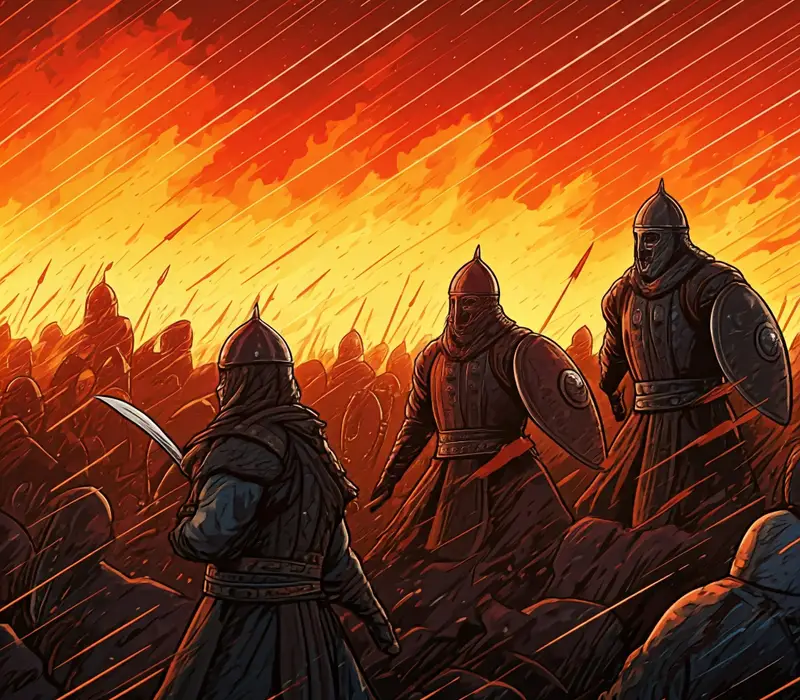The Battle of Qarqar: A Clash of Empires and Alliances in 853 BCE

The Battle of Qarqar (also spelled Qarqur) took place in 853 BCE near the city of Qarqar, located in northwestern Syria. It was a monumental clash between the Assyrian Empire, led by Shalmaneser III, and a coalition of twelve kings, including Ben-Hadad II, the king of Aram-Damascus, and Ahab, the king of Israel. This battle stands out not only for its size—with one of the largest recorded armies of the ancient world—but also because it marks the first mention of certain peoples, such as the Arabs, in recorded history. Shalmaneser III documented the events of the battle on the Kurkh Stele, an Assyrian inscription that provides invaluable insights into the campaign.
The Battle of Qarqar occurred during the period of Assyrian expansion into the Levant between 854 and 846 BCE, when the empire sought to conquer new territories and subjugate local rulers. Despite its inconclusive outcome, this battle is notable for the sheer size of the opposing armies and the collaboration among otherwise rival kingdoms.
---
Shalmaneser III’s Campaign and Preparations
The events leading up to the battle began with Shalmaneser III launching his annual military campaign. According to the Kurkh Stele, the Assyrian king set out from Nineveh on the 14th day of Iyyar (a month in the ancient Mesopotamian calendar), heading westward. His army marched across both the Tigris and Euphrates Rivers without encountering resistance, thanks to the submission of cities along his route. Several cities welcomed Shalmaneser with gifts and tributes, signaling their willingness to align with the Assyrian empire to avoid destruction. Notably, the city of Aleppo offered its submission during the march.
The first significant opposition Shalmaneser faced came from Irhuleni, the king of Hamat. However, the Assyrian forces decisively defeated Irhuleni’s army, and Shalmaneser punished Hamat by razing its cities and fortresses. His swift conquest of Hamat not only demonstrated the strength of the Assyrian army but also allowed Shalmaneser to gather spoils and prepare for the larger confrontation at Qarqar.
---
The Coalition of Twelve Kings
Realizing the imminent threat posed by the Assyrian invasion, Ben-Hadad II of Aram-Damascus formed a coalition of twelve kings to counter the Assyrian advance. The coalition included forces from several major and minor kingdoms, all united by the shared goal of preventing Assyrian dominance over the Levant.
The participating forces of the coalition were:
Ben-Hadad II (Aram-Damascus): 1,200 chariots, 1,200 cavalry, 20,000 infantry
Irhuleni (Hamat): 700 chariots, 700 cavalry, 10,000 infantry
Ahab (Israel): 2,000 chariots, 10,000 infantry
Cilicia: 500 infantry
Musru (possibly an area near Cilicia or Egypt): 1,000 infantry
Arqantu (Tell Arqa): 10 chariots, 10,000 infantry
Arwad: 200 infantry
Usanata (Mount Lebanon region): 200 infantry
Siano (Syrian coastal mountains): Troop numbers unknown
Gindibu the Arab (Dumah in the Arabian Peninsula): 1,000 camel-riders
Baasha son of Ruhubi (the Amurru Kingdom): Several hundred infantry
This coalition represented an impressive collection of military power, showcasing the strategic necessity of cooperation between otherwise rival kings. The inclusion of Arab forces under Gindibu is particularly noteworthy, as it marks the first recorded mention of Arabs in historical sources.
---
The Clash at Qarqar: Strategy and Forces
The battle unfolded near the Orontes River, a crucial geographical point in the region. The Assyrian army was formidable, equipped with a large infantry force, iron weapons, and advanced military technology, including siege engines and heavily armored chariots. Shalmaneser’s strategy relied on his army’s mobility, superior organization, and the ability to break enemy lines using his chariots.
On the other side, the coalition aimed to use its combined strength to halt the Assyrian advance. The diversity of the allied forces, with contributions from various regions, presented both advantages and challenges. While the coalition’s large number of troops gave them strength, their varying languages, tactics, and command structures may have made coordination difficult.
The Aram-Damascus cavalry and the chariots from Israel and Hamat were expected to play key roles in the battle, with infantry forces providing the bulk of the defense. Gindibu’s camel-riders added a unique element to the battle, as camels were known to disrupt enemy horses, giving the coalition a potential tactical advantage.
---
Events of the Battle
The exact details of the Battle of Qarqar are somewhat unclear, as the Kurkh Stele primarily presents the events from Shalmaneser III’s perspective, focusing on his achievements. The stele describes how the Assyrian army engaged the allied forces in a massive confrontation. The battle was fierce, with thousands of soldiers on both sides clashing near the Orontes River.
Despite the Assyrian army’s strength and tactical superiority, the coalition managed to withstand the initial assault, resulting in a standoff. Shalmaneser’s inscription on the Kurkh Stele boasts about his victory, but historians suggest that the battle likely ended in a draw, as there are no records of the Assyrian army advancing further into the region immediately after the battle.
---
Aftermath and Legacy
The Battle of Qarqar marked a critical moment in the Assyrian expansion into the Levant. While the battle did not result in a decisive victory for either side, it demonstrated the potential for regional powers to unite against a common enemy. The alliance, however, was short-lived, as internal conflicts and rivalries among the kings soon resurfaced.
Shalmaneser III continued his annual campaigns in the following years, eventually subjugating many of the kingdoms involved in the coalition. However, the Battle of Qarqar remained significant for its scale and the diversity of the forces involved. The Kurkh Stele, where the events of the battle were recorded, provides modern historians with valuable insights into the politics and military strategies of the ancient Near East.